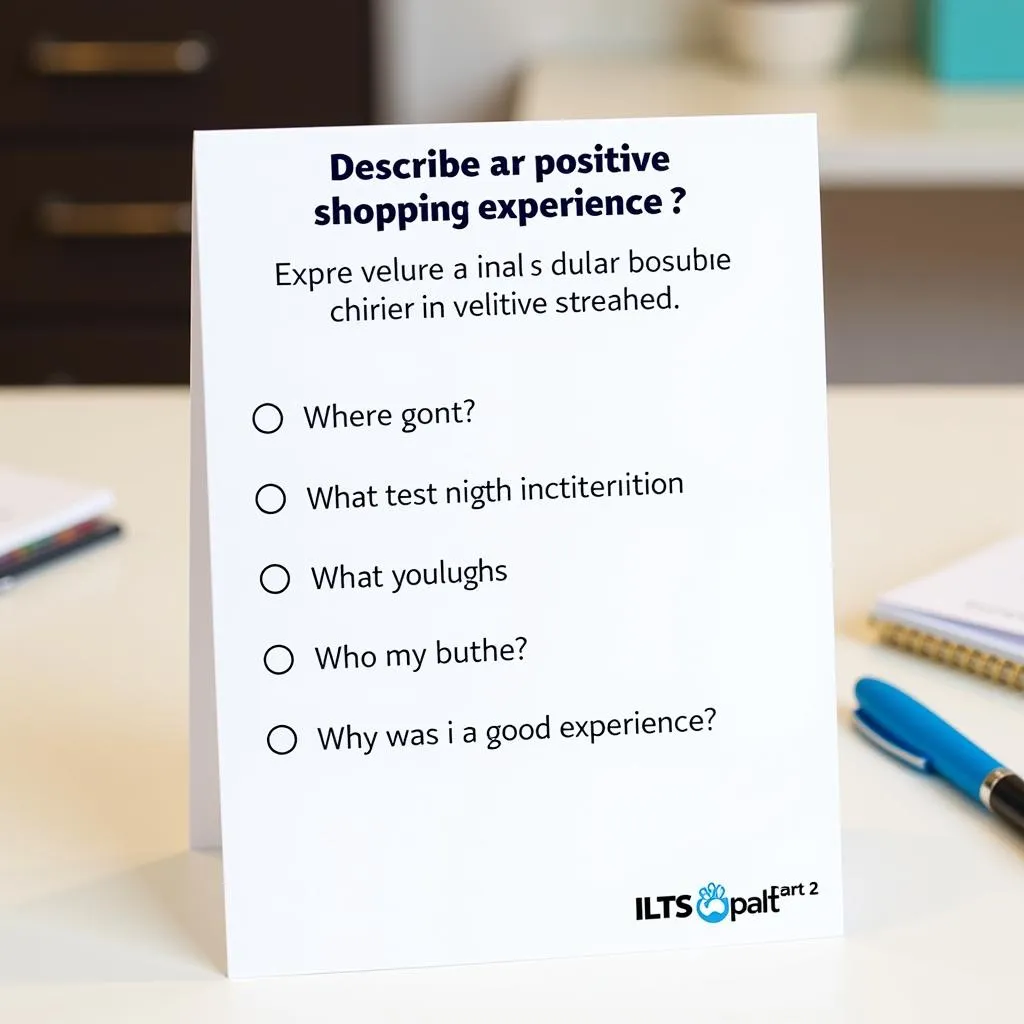Shopping experiences can be a common topic in IELTS Speaking tests, particularly when discussing daily life activities or personal preferences. The ability to describe a positive shopping experience effectively can showcase your English language skills and help you achieve a higher band score. This article will guide you through answering questions related to this topic in all parts of the IELTS Speaking test.
Part 1: Introduction and Interview
In Part 1, the examiner may ask you some general questions about shopping. Here are some common questions you might encounter:
- Do you enjoy shopping?
- How often do you go shopping?
- What kind of shops do you usually visit?
- Do you prefer shopping alone or with others?
Let’s look at a sample answer for the first question:
Examiner: Do you enjoy shopping?
Sample answer (Band 7-8):
“Yes, I do enjoy shopping, especially when I’m looking for something specific. I find it quite exciting to explore different stores and discover new products. However, I try to be mindful of my spending and only shop when necessary. I particularly enjoy shopping for books and electronics, as I find these items both useful and entertaining.”
Part 2: Long Turn
For Part 2, you might receive a cue card related to describing a shopping experience. Here’s a sample cue card:
Describe a shopping experience that went well
You should say:
- Where you went shopping
- What you bought
- Who you were with
- And explain why you think it was a good experience IELTS Speaking Part 2 Cue Card: Describe a positive shopping experience
IELTS Speaking Part 2 Cue Card: Describe a positive shopping experience
Here’s a sample answer for Band 8-9:
“I’d like to talk about a particularly pleasant shopping experience I had last month when I visited a newly opened shopping mall in the city center. I went there with my best friend, Sarah, as we both needed to buy some new clothes for an upcoming wedding.
The mall was impressively designed, with a spacious layout and a wide variety of stores. We spent most of our time in a high-end boutique that specialized in formal wear. What made this experience stand out was the exceptional customer service we received. The staff were not only knowledgeable about their products but also incredibly attentive to our needs.
After trying on several outfits, I ended up purchasing a stunning midnight blue cocktail dress that fit me perfectly. Sarah found a lovely floral maxi dress that complemented her style beautifully. What’s more, the store offered a tailoring service, so we could have minor adjustments made to ensure the perfect fit.
I consider this a good experience for several reasons. Firstly, the atmosphere in the mall was vibrant and welcoming, which made shopping enjoyable rather than stressful. Secondly, the quality of the clothes we found was excellent, and we both felt confident in our purchases. Lastly, the personalized attention we received from the staff made us feel valued as customers and helped us make informed decisions.
Overall, this shopping trip was a perfect blend of efficiency and enjoyment. We accomplished our goal of finding suitable outfits for the wedding while also having a fun day out together. It’s experiences like these that remind me why I enjoy shopping, especially when it’s shared with good company.”
Follow-up questions:
- How did the customer service contribute to your positive experience?
- Do you think the ambiance of a store affects your shopping decisions?
Sample answer for question 1 (Band 8-9):
“The customer service played a crucial role in making this experience positive. The staff demonstrated exceptional product knowledge, which helped us make informed choices. They were also highly attentive without being pushy, striking the perfect balance between being helpful and giving us space to decide. Their personalized recommendations based on our preferences and body types were particularly valuable. Moreover, their friendly and professional demeanor created a welcoming atmosphere that made the entire shopping process enjoyable and stress-free.”
Part 3: Two-way Discussion
In Part 3, the examiner might ask more abstract questions related to shopping experiences. Here are some potential questions:
- How have shopping habits changed in recent years?
- What impact do you think online shopping has had on traditional retail stores?
- In what ways can businesses improve the shopping experience for customers?
Let’s look at a sample answer for the third question:
Examiner: In what ways can businesses improve the shopping experience for customers?
Sample answer (Band 8-9):
“There are several ways businesses can enhance the shopping experience for their customers. Firstly, they can focus on providing exceptional customer service. This involves training staff to be knowledgeable about products, attentive to customer needs, and capable of offering personalized recommendations.
Secondly, businesses can leverage technology to create a more seamless shopping experience. This could include implementing user-friendly mobile apps, offering virtual try-on features for clothing and accessories, or using augmented reality to help customers visualize products in their homes.
Another important aspect is creating a pleasant in-store environment. This could involve thoughtful store layouts, comfortable fitting rooms, and an overall ambiance that aligns with the brand’s identity and appeals to the target demographic.
Furthermore, businesses should consider offering omnichannel experiences that integrate online and offline shopping. For instance, they could provide options like ‘click and collect’ or the ability to return online purchases in-store.
Lastly, personalization is becoming increasingly important. Businesses can use data analytics to understand customer preferences and tailor their offerings accordingly, whether through targeted promotions or curated product recommendations.
By implementing these strategies, businesses can create more engaging, convenient, and enjoyable shopping experiences that are likely to foster customer loyalty and drive sales.”
Key Vocabulary and Phrases for High Scores
To achieve a high band score, it’s crucial to use a range of vocabulary and complex sentence structures. Here are some key terms and phrases that can elevate your response:
-
Exceptional customer service /ɪkˈsepʃənl ˈkʌstəmə ˈsɜːvɪs/ (noun phrase): Outstanding assistance and care provided to customers.
Example: “The exceptional customer service made our shopping experience truly memorable.” -
High-end boutique /haɪ end buːˈtiːk/ (noun phrase): An upscale, specialized shop selling fashionable clothes and accessories.
Example: “We found the perfect outfits at a high-end boutique in the new mall.” -
Personalized attention /ˈpɜːsənəlaɪzd əˈtenʃn/ (noun phrase): Individual care and focus given to each customer.
Example: “The staff provided personalized attention, helping us find exactly what we needed.” -
Leverage technology /ˈlevərɪdʒ tekˈnɒlədʒi/ (verb phrase): To use technology to maximum advantage.
Example: “Many retailers are leveraging technology to enhance the shopping experience.” -
Omnichannel experience /ˈɒmnɪtʃænl ɪkˈspɪəriəns/ (noun phrase): A multi-channel approach to sales that provides customers with a seamless shopping experience.
Example: “The store offers an omnichannel experience, allowing customers to shop online and in-store with equal ease.”
Describe a bad service you received in a restaurant or shop can be an interesting contrast to discussing positive experiences, helping you demonstrate your ability to describe different scenarios effectively.
Examiner’s Advice
To achieve a high score in the IELTS Speaking test when describing a shopping experience:
- Use a wide range of vocabulary related to shopping, customer service, and personal experiences.
- Employ complex sentence structures and idiomatic expressions naturally.
- Provide specific details and examples to support your points.
- Show your ability to discuss both concrete experiences (Parts 1 and 2) and abstract ideas (Part 3).
- Maintain fluency by practicing speaking about various shopping-related topics.
Remember, the key to success is not just about memorizing answers, but about developing the ability to communicate effectively on a range of subjects. Regular practice and expanding your vocabulary will help you describe a time when you had to adapt to a change in your life, which could include adapting to new shopping experiences or technologies.
 IELTS Speaking Practice Session
IELTS Speaking Practice Session
By following these guidelines and incorporating varied vocabulary and complex structures, you’ll be well-prepared to discuss shopping experiences and related topics in your IELTS Speaking test. Whether you’re describing a fish market you visited or a high-end boutique, the skills you develop will help you communicate effectively across a range of subjects.


